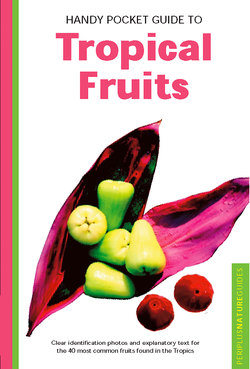Читать книгу Handy Pocket Guide to Tropical Fruits - Wendy Hutton - Страница 5
На сайте Литреса книга снята с продажи.
ОглавлениеIntroduction
One of the many joys of Thailand is the kingdom's stunning array of ambrosial fruits. Their succulent sweetness, astonishingly varied shapes, colours, sizes and heady perfumes delight not only visitors, but also send the Thais into raptures as each fruit comes into season.
Pass a durian stall, where this notoriously pungent, spiky "king of fruits" is on sale, and you'll see enthusiastic crowds devouring the creamy rich flesh at makeshift tables or even just standing or squatting on the pavement, too eager to enjoy the fruit to wait to take it home. Thailand is renowned throughout Asia for the standard of its magnificent durians, mangoes and pomelos, and also for some of the cooler climate fruits grown in the hills around Chiang Mai.
Permanent local markets carry seasonal fruits as well as the many fruits which are available year round, while in some areas, special fruit stalls are set up (especially near the orchards). It is common to find stalls at food centres and markets offering cut fruits, while itinerant vendors sell these as well as prepare special local fruit salads, often of tart or unripe fruits mixed with pungent sauces. Fruits such as pineapple, pomelo and guava are often dipped into tangy nam phrik sauces, or simply sprinkled with salt.
The art of carving fruits and vegetables, refined in the palaces of Bangkok, is carried on in displays at elegant hotels and restaurants, yet even at streetside stalls you will find peeled pineapples with their "eyes" cleverly removed in a perfect spiral. Travellers with sensitive constitutions should ensure themselves of the standard of hygiene of any stall selling cut fruit, to avoid stomach upsets.
As Thailand and other countries of tropical Asia modernise at an increasing pace, some of the less commercial varieties of fruit—those that must be eaten within a day or so of ripening, others that are too fragile to be transported without considerable care—are difficult to find in major cities. Out in the smaller towns and villages, however, one can still come across unusual delights such as the fragrant "apple" of the cashew tree or the purplish-black Java plum. This book is designed to act as a guide to the more common fruits found in Thailand and other regions of tropical Asia. There are, of course, many others not included, such as those found only in cooler hilly regions or others available for a very brief season only.
Included at the back of the book are a selection of recipes illustrating some of the many ways in which fresh fruit may be served. Most people would agree, however, that nothing rivals a mouthful of meltingly smooth, juicy mango, or a wedge or two of sweet sour pineapple drenched with thirst-quenching juice. Indeed, it could be argued that to sample the fruits of Thailand is to experience a preview of Paradise.
